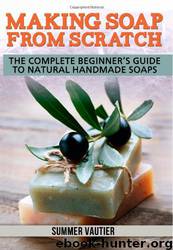Making Soap From Scratch: The Complete Beginner's Guide to Natural Handmade Soaps by Summer Vautier

Author:Summer Vautier [Vautier, Summer]
Language: eng
Format: epub
ISBN: 9780615847986
Amazon: 0615847986
Publisher: Thrive Press
Published: 2013-07-15T04:00:00+00:00
Liquid Colors
Liquid colorants are pigmented colors used by many soap makers. The pros for liquid colorants include convenience and ease of use. They are also readily accessible from soap suppliers locally and online. The main con for using liquid colorant is the actual coloring quality. The colors tend to slightly fade during saponification. This is particularly true with cheaper liquid color brands.
Oxides
An oxide colorant comes in powder form. It is made in a lab to ensure cleanliness and purity; however, oxides are exactly duplicated from natural minerals once mined from the Earth. Micas and oxides are the only colorants approved by the U.S. Federal Drug Association for soap making. The only con for oxides is that they can be a bit messy, due to the powder. But the pros are many! Oxide powders stay very true to color. You can easily blend colors. If you want to lighten a color, you can blend in a bit of titanium dioxide too. Titanium dioxide can be used to whiten the soap if you are using ingredients that naturally create a tan bar.
One important tip for oxides is to wet the powder by blending in some oil or soap base before you add it in to the main mixture. Let it dissolve. If you skip this step you'll have little clumps of color in your soap instead of even color throughout.
Download
This site does not store any files on its server. We only index and link to content provided by other sites. Please contact the content providers to delete copyright contents if any and email us, we'll remove relevant links or contents immediately.
On Writing A Memoir of the Craft by Stephen King(4864)
The Doodle Revolution by Sunni Brown(4690)
A Simplified Life by Emily Ley(4099)
Mummy Knew by Lisa James(3637)
Marijuana Grower's Handbook by Ed Rosenthal(3624)
Better Homes and Gardens New Cookbook by Better Homes & Gardens(3529)
Figure Drawing for Artists by Steve Huston(3384)
Paper Parties by Erin Hung(3373)
Draw Your Day by Samantha Dion Baker(3292)
The Genius of Japanese Carpentry by Azby Brown(3228)
Japanese Design by Patricia J. Graham(3112)
The Code Book by Simon Singh(3077)
Dangerous Girls by Haas Abigail(2981)
Lions and Lace by Meagan Mckinney(2926)
The Curated Closet by Anuschka Rees(2915)
How to Make Your Own Soap by Sally Hornsey(2834)
The Checklist Manifesto by Atul Gawande(2782)
The Wardrobe Wakeup by Lois Joy Johnson(2733)
Zero to Make by David Lang(2727)
